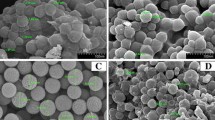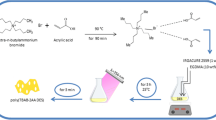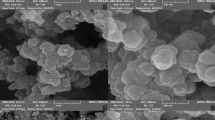Abstract
A novel hybrid polymer was developed and evaluated as a sorbent for the matrix solid-phase dispersion (MSPD) extraction of pesticides. The hybrid polymer was synthesized by the sol–gel method and by free radical polymerization. The chemical structure of the resulting hybrid polymer (SiO2–PVI) was confirmed by Fourier transform infrared spectroscopy (FT-IR). Thermal analyses suggest that the polymer consists of an organic/inorganic ratio of 28:72 wt/wt%. Scanning electron microscopy (SEM) and elemental analysis (EDS) revealed particle aggregates and a rough surface and suggested that the polymer is primarily composed of SiO2. The obtained pore size was appropriate for use in a solid-phase extraction support. X-ray photoelectron spectroscopy (XPS) was used to assess the surface composition of the hybrid polymer and indicated the presence of C, N, O, and Si. The material was tested for extraction of five selected organophosphorus pesticides (OPPs) in propolis using gas chromatography–mass spectrometry (GC/MS). In experiments performed in triplicate at 1.0 μg mL−1, pesticide recovery was in the range of 81–122 %. In addition, the sorbent hybrid polymer (SiO2–PVI) demonstrated good repeatability (RSD ≤ 11 %), on the same order as C18 (commercial sorbent) when tested under the same conditions. These results suggest that SiO2–PVI hybrid polymer is a good sorptive material that is comparable to the commercially utilized C18 and can be used in MSPD for the extraction of organophosphorus pesticides.







Similar content being viewed by others
References
Lemos VA, Gómez-Teixeira LS, Almeida Bezerra M, Spínola-Costa AC, Teixeira-Castro J, Martins-Cardoso LA, Santiago de Jesús D, Souza-Santos E, Xavier-Baliza P, Novaes-Santos L (2008) New materials for solid-phase extraction of trace elements. Appl Spectrosc Rev 1217:303–334
Capriotti AL, Cavaliere C, Giansanti P, Gubbiotti R, Samperi R, Laganá A (2010) Recent developments in matrix solid-phase dispersion extraction. J Chromatogr A 16:2521–2532
Barker SA (2007) Matrix solid-phase dispersion (MSPD). J Biochem Biophys Methods 70:151–162
Lozowicka B, Jankowska M, Rutkowska E, Kaczynski P, Hrynko I (2012) Comparison of extraction techniques by matrix solid phase dispersion and liquid-liquid for screening 150 pesticides from soil, and determination by gas chromatography. Pol J Environ Stud 21:973–992
Bogialli S, Di Corcia A (2007) Matrix solid-phase dispersion as a valuable tool for extracting contaminants from foodstuffs. J Biochem Biophys Methods 70:163–179
Zhang L, Liu S, Cui X, Pan C, Zhang A, Chen F (2012) A review of sample preparation methods for the pesticide residue analysis in foods. Cent Eur J Chem 10:900–925
Souza S, Bolzan CM, Jaime E, Venquiaruti AL, Gaspar CM, Bianchini A, Primel EG (2013) A vortex-assisted MSPD method for the extraction of pesticides residues from fish liver and crab hepatopancreas with determination by GC-MS. Talanta 112:63–68
García M, Canosa P, Rodríguez I (2008) Trends and recent applications of matrix solid phase dispersion. Anal Bioanal Chem 391:963–974
Gilar M, Bouvier E, Compton B (2001) Advances in sample preparation in electromigration, chromatographic and mass spectrometric separation methods. J Chromatogr A 909:111–135
Fontanals N, Galiá M, Marcé RM, Borrull F (2004) Comparison of hydrophilic polymeric sorbents for on-line solid-phase extraction of polar compounds from aqueous samples. Chromatographia 60:511–515
Fontanals N, Marcé RM, Borrull F (2007) New materials in sorptive extraction techniques for polar compounds. J Chromatogr A 1152:14–31
Żwir-Ferenc A, Biziuk M (2006) Solid phase extraction technique–trends, opportunities and applications. Pol J Environ Stud 15:677–690
Toribio L, Moyano E, Puignou, Galceran MT (2000) Comparison of different commercial solid-phase extraction cartridges used to extract heterocyclic amines from a lyophilized meat extract. J Chromatogr A 880:101–112
Fontanals N, Marcé R, Galiá M, Borull F (2004) Synthesis of hydrophilic sorbents from N-vinylimidazole/divinylbenzene and the evaluation of their sorption properties in the solid-phase extraction of polar compounds. J Polym Sci Pol Chem 42:2019–2025
An F, Feng X, Gao B (2009) Adsorption mechanism and property of a novel adsorption material PAM/SiO2 towards 2,4,6-trinitrotoluene. J Hazard Mater 168:352–357
An F, Gao B, Feng X (2009) Adsorption mechanism and property of novel composite material PMAA/SiO2 towards phenol chemical. Chem Eng J 153:108–113
Sun M, Ma X, Wang J, Wang W, Wu Q, Wang C, Wang Z (2013) Graphene grafted silica-coated Fe3O4 nanocomposite as absorbent for enrichment of carbamates from cucumbers and pears prior to HPLC. J Sep Sci 36:1478–1485
Mei M, Wan A, Abdala AE (2014) Sol–gel hybrid methyltrimethoxysilane–tetraethoxysilane as a new dispersive solid-phase extraction material for acrylamide determination in food with direct gas chromatography–mass spectrometry analysis. Food Chem 158:302–309
Zhu Y, Yang S, Chen G, Xing J (2014) Single “click” synthesis of a mixed-mode silica sorbent and application in matrix solid-phase dispersion extraction of β-agonistsfrom porcine liver. J Chromatogr A 1354:101–108
Wen Y, Chen L, Li J, Liu D, Chen L (2014) Recent advances in solid-phase sorbents for sample preparation prior to chromatographic analysis. Trac-Trends Anal Chem 59:26–41
Pyun J, Matyjaszewski K (2001) Synthesis of nanocomposite organic/inorganic hybrid materials using controlled/“living” radical polymerization. Chem Mater 13:3436–3448
Pekel N, Guven O (2002) Synthesis and characterization of poly(N-vinylimidazole) hydrogels crosslinked by gamma irradiation. Polym Int 51:1404–1410
Li J, Zhang Y, Ping Z, Li M, Zhang Q (2011) Synthesis and endotoxin removal properties of a novel affinity sorbent with poly(1-vinylimidazole) as the ligand. Process Biochem 46:1462–1468
Bange JP, Patil LS, Gautam DK (2008) Growth and characterization of SiO2 films deposited by flame hydrolysis deposition system for photonic device application. Prog Electromagn Res 3:165–175
Wang H, Meng S, Xu P, Zhong W, Du Q (2007) Effect of traces of inorganic content on thermal stability of poly(methyl methacrylate) nanocomposites. Polym Eng Sci 47:302–307
Strat M, Vasiliu S, Strat G, Luca C, Grecu I, Gurlui S, Stratulat SI (2006) Spectral and thermogravimetric analysis of some poly(carboxybetaine)s polymers. J Optoelectron Adv Mater 8:181–184
Park JT, Seo JA, Ahn SH, Kim JH, Kang SW (2010) Surface modification of silica nanoparticles with hydrophilic polymers. J Ind Eng Chem 17:517–522
Sing KSW, Everett DH, Haul RAW, Moscou L, Pierotti RA, Rouquerol J, Siemieniewska T (1985) Reporting physisorption data for gas/solid systems with special reference to the determination of surface area and porosity (recommendations 1984). Pure Appl Chem 57:603–619
Walkarius A, Collinson M (2009) Analytical chemistry with silica sol-gels: traditional routes to new materials for chemical analysis. Ann Rev Anal Chem 2:121–143
Osmana B, Kara A, Uzunb L, Besirli N, Denizli (2005) A vinyl imidazole carrying metal-chelated beads for reversible use in yeast invertase adsorption. J Mol Catal B 37:88–94
Fibikar S, Rinke MT, Schafer A, De Cola L (2010) Quantification of cation-exchange zeolites by XPS and EDS: a comparative study. Micro Meso Mater 132:296–299
Zhang H, Lei X, Su Z, Liu P (2007) A novel method of surface-initiate atom transfer radical polymerization of styrene from silica nanoparticles for preparation of monodispersed core-shell hybrid nanospheres. J Polym Res 14:253–260
Benne D, Maccallini E, Rudolf P, Sooambar C, Prato M (2006) X-ray photoemission spectroscopy study on the effects of functionalization in fulleropyrrolidine and pyrrolidine derivatives. Carbon 44:2896–2903
Zhang H, Li C, Guo J, Zang L, Luo J (2012) In situ synthesis of poly(methyl methacrylate)/SiO2 hybrid nanocomposites via “grafting onto” strategy based on UV irradiation in the presence of iron aqueous solution. J Nanomater 2012:1–9
Walker P, Crane E (1987) Constituents of propolis. Apidologie 18:327–334
Acknowledgments
This work was supported by Consejo Nacional de Ciencia y Tecnología, CONACyT (83390). The authors are grateful to M. C. Lizbeth Triana Cruz and M. C. Alejandra Núñez Pineda for their technical support in the FT-IR measurements and to L.Q.I. Nayely Pineda Aguilar and M. C. Alberto Toxqui Teran for their technical assistance in the structural analysis.
Author information
Authors and Affiliations
Corresponding author
Rights and permissions
About this article
Cite this article
Medina-Dzul, K., Carrera-Figueiras, C., Pérez-Padilla, Y. et al. SiO2/polyvinylimidazole hybrid polymer as a sorbent for extraction by matrix solid-phase dispersion (MSPD): synthesis, characterization, and evaluation. J Polym Res 22, 45 (2015). https://doi.org/10.1007/s10965-015-0677-7
Received:
Accepted:
Published:
DOI: https://doi.org/10.1007/s10965-015-0677-7




